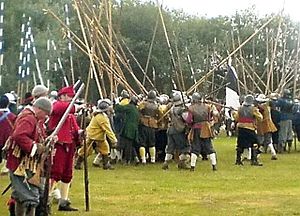| Battle of Turnham Green | |||||||
|---|---|---|---|---|---|---|---|
| Part of the First English Civil War | |||||||
 | |||||||
| |||||||
| Belligerents | |||||||
| Parliamentarians | Royalists | ||||||
| Commanders and leaders | |||||||
| Earl of Essex, Philip Skippon | King Charles I | ||||||
| Strength | |||||||
| 24,000[1] | 13,000[2] | ||||||
| Casualties and losses | |||||||
| light | light | ||||||
The Battle of Turnham Green occurred 13 November 1642 near the village of Turnham Green, at the end of the first campaigning season of the First English Civil War. On the battlefield, the engagement resulted in a standoff between the forces of King Charles I and the much larger Parliamentarian army under the command of the Earl of Essex. However, in successfully blocking the Royalist army's way to London, the Parliamentarians gained an important strategic victory because the standoff forced Charles and his army to retreat to Oxford for secure winter quarters.
Background[]
After the Battle of Edgehill (23 October) King Charles captured Banbury (27 October) and was greeted by cheering crowds as he arrived in Oxford on 29 October. Charles' nephew and cavalry commander, Prince Rupert of the Rhine, swept down the Thames Valley, capturing Abingdon, Aylesbury and Maidenhead, from where he attempted to capture Windsor, although he failed in that attempt because of Parliamentary strength there. After this, many officers wanted to open peace negotiations, contrary to Rupert’s desire to carry on to London, but the king agreed with the officers and so the Earl of Essex managed to overtake them and reach London with his Parliamentary army by 8 November.
Prelude[]
On the 12 November Rupert with a large cavalry detachment stormed Brentford and then proceeded to sack the town. This action encouraged those Londoners who feared for their property to side with the Parliamentarians.[3] On 13 November Essex's army, with the London trainbands and other London citizenry, assembled as an army of about 24,000 on Chelsea Field. They advanced to Turnham Green in the vicinity of the main body of the Royalist army.[3]
Battle[]
The Royalist army of 7,000-12,000 was short of ammunition and probably too small to attack the 24,000 strong Parliamentarian army. Also the King was advised that to engage such an oddly assorted army containing what was obviously a large contingent of armed civilians (namely the Trained Bands under Philip Skippon), would not endear him to London, and it was too early in the war for the Royalists to contemplate taking London without the support of a sizable part of London's population.[3]
With the end of campaigning season close at hand, Charles decided not to press the issue and withdrew. So after a slight cannonade, the Parliamentarians secured a victory without engaging in the battle, which was fortunate for them, as many of their number had never seen a battle before and were not used to army discipline formations and deployments. John Hampden, with something of the fire and energy of his cousin, Oliver Cromwell, urged the Earl of Essex to turn both flanks of the Royal army via Acton and Kingston; experienced professional soldiers, however, urged Essex not to trust the London men to hold their ground, while the rest manoeuvred. Hampden's advice was undoubtedly premature. A Battle of Worcester (1651) was not within the power of the Parliamentarians of 1642. In Napoleon's words: "one only manoeuvres around a fixed point",[4] and the city levies at that time were certainly not, vis-à-vis Rupert's cavalry, a fixed point.[4]
Aftermath[]
Charles (once more contrary to Rupert's advice) retreated back up the Thames Valley towards Oxford (losing the possible chance for a flanking movement through loyal Kent), where Charles set up his headquarters for the rest of the war. Never again during the Civil War would the Royalists come as close to capturing London and without London they could not win the war.[4]
Notes[]
- ↑ Royle p. 206
- ↑ Plant, David. "1642: First campaigns of the English Civil War". The British Civil Wars & Commonwealth website. Archived from the original on 9 December 2008. http://web.archive.org/web/20081209080820/http://www.british-civil-wars.co.uk/military/1642-edgehill.htm. Retrieved 13 November 2008.
- ↑ 3.0 3.1 3.2 Royle pp. 202-207
- ↑ 4.0 4.1 4.2 Encyclopædia Britannica Eleventh Edition article "GREAT REBELLION" Section "4. Battle of Edgehill"
References[]
- Royle, Trevor (2004). The British Civil War: The Wars of the Three Kingdoms, 1638–1660. New York: Palgrave MacMillan. ISBN 0-312-29293-7.
- Attribution
This article incorporates text from a publication now in the public domain: Chisholm, Hugh, ed. "GREAT REBELLION" Encyclopædia Britannica Cambridge University Press
External links[]
Coordinates: 51°29′31″N 0°15′59″W / 51.4919°N 0.2664°W
The original article can be found at Battle of Turnham Green and the edit history here.